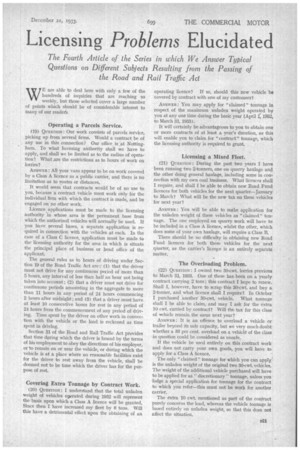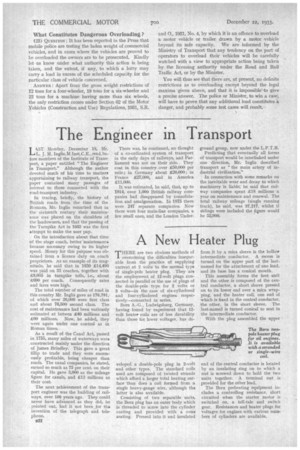Licensing Problems Elucidated
Page 27

Page 28

If you've noticed an error in this article please click here to report it so we can fix it.
The Fourth Article of the Series in which We Answer Typical Questions on Different Subjects Resulting from the Passing of the Road and Rail Traffic Act
WE are able to deal hero with only a few of the hundreds of inquiries that are reaching us weekly, but those selected cover a large number of points which should be of considerable interest to many of our reader's.
Operating a Parcels Service.
(19) QUESTION OUT work consists of parcels service, picking up from several firms. Would a contract be of any use in this connection? Our office is at Notting
' ham. To what licensing authority shall we have to apply, and shall we be limited as to the radius of operation? What .are the restrictions as to hours of work on lorries?
ANSWER: All your vans appear to be on work covered by a Class A licence as a public carrier, and there is no limitation as to routes or distances.
It would seem that contracts would be of no use to you, because a contract vehicle must work only for the individual firm with which the contract is made, and be engaged on noother work.
Licence applications must be made to the licensing authority in whose area is the permanent base from Which the authorized vehicles will normally be used. If you have several bases, a separate application is required in connection with the vehicles at each. In the case of a Class C licence, application must be made to the licensing authority for the area in which is situate the principal place of business or head office of the applicant.
The general rules as to hours of driving under Section 19 of the Road Traffic Act are : (1) that the driver must not drive for any continuous period of more than 5 hours, any interval of less than hall an hour not being taken into account ; (2) that a driver must not drive for continuous periods amounting in the aggregate to more than 11 hours in any period of 24 hours commencing 2 hours after midnight; and (3) that a driver must have at least 10 consecutive hours for rest in any period of 24 hours from the commencement of any period of driving. Time spent by the driver on other work in connection with the vehicle or the load is reckoned as time spent in driving.
Section 31 of the Road and Rail Traffic Act provides that time during which the driver is bound by the terms of his employment to obey the directions of his employer, or to remain on or near the vehicle, or during which the vehicle is at a place where no reasonable facilities exist for the driver to rest away from the vehicle, shall be deemed not to be time which the driver has for the purpose of rest.
Covering Extra Tonnage by Contract Work.
(20) QUESTION: I understand that the total unladen weight of vehicles operated during 1932 will represent the basis upon which a Class A licence will be granted. Since then I have increased my fleet by 6 tons. Will this have a detrimental effect upon the obtaining of an
operating licence? If so, should this new vehicle be covered by contract with one of my customers?
ANSWER: You may apply for "claimed" tonnage in respect of the maximum unladen weight operated by you at any one time during the basic year (April 1, 1932, to March 31, 1933).
It will certainly be advantageous to you to obtain one or more contracts of at least a year's duration, as this will enable you to claim for "contract" tonnage, which the licensing authority is required to grant.
Licensing a Mixed Fleet.
(21) QUESTION: During the past two years I have been running two 2-tonners, one on quarry haulage and the other doing general haulage, including some in connection with my own coal business, What licences shall I require, and shall I be able to obtain nGw Road Fund licences for both vehicles for the next quarter—January to March? What will be the new tax on these vehicles for next year?
ANSWER: You will be able to mike application for the unladen weight of these vehicles as "claimed" tonnage. The one employed on quarry work will have to be included in a Class A licence, whilst the other, which does some of your own haulage, will require a Class B.
There should be no difficulty in obtaining new Road Fund licences for both these vehicles for the next quarter, as the carrier's licence is an entirely separate matter..
The Overloading Problem.
(22) QUESTION: I owned two 30-cwt. lorries previous to March 31, 1933. One of these has been on a yearly contract carrying .2 tons ; this contract I hope to renew. Shall I, however, have to scrap this 30-cwt. and buy a 2-tonner, and what licence shall I require? In October I purchased another 30-cwt. vehicle. What tonnage shall I be able to claim, and may I ask for the extra 10 cwt. carried by contract? Will the tax for this class of -vehicle remain the same next year?
ANSWER: It is an offence to overload a vehicle or trailer beyond its safe capacity, but we very much doubt whether a 33 per cent. overload on a vehicle of the class in question could he considered as unsafe.
If the vehicle be used entirely on this contract work and does not carry your own goods, you will have to apply for a Class A licence. The only "claimed" tonnage for which you can apply' is the unladen weight of the original two 30-cwt. vehicles. The weight of the additional vehicle purchased will have to be applied for as " discretionary " tonnage., unless you lodge a special application for tonnage for the contract to which you refer—this must not be work for another carrier.
The extra 10 cwt. mentioned as part of the contract purely concerns the whereas the vehicle tonnage is based entirely on unladen weight, so that this does not affect the situation.
What Constitutes Dangerous Overloading ?
(23) QUESTION: It has been reported in the Press that mobile police are testing the laden weight of commercial vehicles, and in cases where the vehicles are proved to he overloaded the owners are to be prosecuted. Kindly let us know under what authority this action is being taken, and the extent, if any, to which a lorry may carry a load in excess of the scheduled capacity for the particular class of vehicle concerned.
ANSWER: Apart from the gross weight restrictions of 12 tons for a four-wheeler, 19 tons for a six-wheeler and 22 tons for a machine having more than six wheels, the only restriction comes under Section 32 of the Motor Yehicles (Construction and Use) Regulations, 1931, S.R.
and 0., 1931, No. 4, by which it is an offence to overload a motor vehicle or trailer drawn by a motor vehicle beyond its safe capacity. We are informed by the Ministry of Transport that any tendency on the part of operators to overload their vehicles will be carefully watched with a view to appropriate action being taken by the licen_sing authority under the Road and Rail Traffic Act, or by the Minister, You will thus see that there arc, at present, no definite restrictions as to overloading except beyond the legal maxima given above, and that it is impossible.' to give a precise answer. The police or Minister, to win a case, will have to prove that any additional load constitutes a danger, and probably some test cases will result.












































































